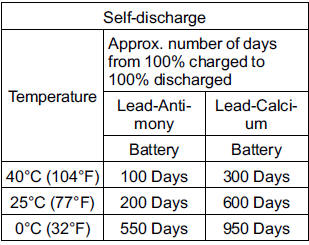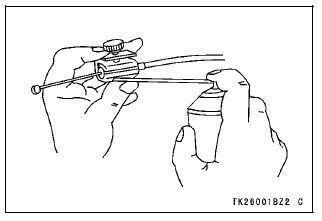 Kawasaki Z1000SX - Owner's Manual > Battery
Kawasaki Z1000SX - Owner's Manual > Battery
The battery installed in this motorcycle is a sealed type, so it is not necessary to check the battery electrolyte level or add distilled water.
The sealing strip should not be pulled off once the specified electrolyte has been installed in the battery for initial service.
However, in order to maximize battery life and ensure that it will provide the power needed to start the motorcycle you must properly maintain the battery's charge. When used regularly, the charging system in the motorcycle helps keep the battery fully charged. If your motorcycle is only used occasionally or for short periods of time, the battery is more likely to discharge.
Due to their internal composition, batteries continually self discharge.
The discharge rate depends on the type of battery and ambient temperature. As temperature rises, so does the discharge rate. Every 15ºC (59ºF) doubles the rate.
Electrical accessories, such as digital clocks and computer memory, also draw current from the battery even when the key is switched off. Due to a combination of such "key-off" draws and hot temperature, a battery can go from fully charged to completely discharged in a matter of days.


In extremely cold weather the fluid in an inadequately charged battery can easily freeze, which can crack the case and buckle the plates. A fully charged battery can withstand sub-freezing temperature with no damage.
Battery Sulfation
A common cause of battery failure is sulfation.
Sulfation occurs when the battery is left in a discharged condition for an extended time. Sulfate is a normal by product of the chemical reactions within a battery. But when continuous discharge allows the sulfate to crystallize in the cells, the battery plates become permanently damaged and will not hold a charge. Battery failure due to sulfation is not warrantable.
Battery Maintenance
It is the owner's responsibility to keep the battery fully charged. Failure to do so can lead to battery failure and leave you stranded.
If you are riding your vehicle infrequently, inspect the battery voltage weekly using a voltmeter. If it drops below 12.8 volts, the battery should be charged using an appropriate charger (check with a Kawasaki dealer). If you will not be using the motorcycle for longer than two weeks, the battery should be charged using an appropriate charger. Do not use an automotive-type quick charger that may overcharge the battery and damage it.
NOTE
- Leaving the battery connected causes the electrical components (clock etc) to make the battery discharged, resulting the over discharge of the battery. In this case, the repair or replacement of the battery is not included in the warranty. If you do not drive for four weeks or more, disconnect the battery from the vehicle.
Kawasaki-recommended chargers are:
Battery Mate 150-9
OptiMate 4
Yuasa MB-2040/2060
Christie C10122S
If the above chargers are not available, use equivalent one.
For more details, ask a Kawasaki dealer.
Battery Charging
- Remove the battery from the motorcycle (see Battery Removal).
- Attach the leads from the charger and charge the battery at a rate (amperage × hours) that is indicated on the battery. If it is not possible to read the rate, charge the battery at an amperage that is about 1/10th of the battery capacity.
- The charger will keep the battery fully charged until you are ready to reinstall the battery in the motorcycle (see Battery Installation).
NOTICE Never remove the sealing strip, or the battery can be damaged.
Do not install a conventional battery in this motorcycle, or the electrical system cannot work properly.
NOTE
- If you charge the sealed battery, never fail to observe the instructions shown in the label on the battery.
Battery Removal
- Remove the rider's seat (see Seats section in the GENERAL INFORMATION chapter).
- Remove the red cap from the (+) terminal.
- Disconnect the cables from the battery, first from the (-) terminal and then the (+) terminal.

- (+) Terminal
- (-) Terminal
- Take the battery out of the case.
- Clean the battery using a solution of baking soda and water. Be sure that the wire connections are clean.
Battery Installation
- Place the battery in the battery case.
- Connect the (+) cable to the (+) terminal, and then connect the (-) cable to the (-) terminal.
NOTICE Installing the (-) cable to the (+) terminal of the battery or the (+) cable to the (-) terminal of the battery can seriously damaged the electrical system.
- Put a light coat of grease on the terminals to prevent corrosion.
- Cover the (+) terminal with the red cap.
- Reinstall the removed parts.
Headlight Beam
Horizontal Adjustment
The headlight beam is adjustable horizontally. If not properly adjusted horizontally, the beam will point to one side rather than straight ahead.
- Turn the horizontal adjuster in or out until the beam points straight ahead.
Vertical Adjustment
The headlight beam is adjustable vertically. If adjusted too low, neither low nor high beam will illuminate the road far enough ahead. If adjusted too high, the high beam will fail to illuminate the road close ahead, and the low beam will blind oncoming drivers.
- Turn the vertical adjuster in or out to adjust the headlight vertically.

- Horizontal Adjuster
- Vertical Adjuster
NOTE
- On high beam, the brightest point should be slightly below horizontal with the motorcycle on its wheels and the rider seated. Adjust the headlight to the proper angle according to local regulations.
NOTICE When handling the quartz-halogen bulbs, never touch the glass portion with bare hands. Always use a clean cloth. Oil contamination from hands or dirty rags can reduce bulb life or cause the bulb to explode.

Fuses
Fuses are arranged in the fuse box located under the rider's seat. The main fuse is located under the fuel tank. If a fuse fails during operation, inspect the electrical system to determine the cause, and then replace it with a new fuse of proper amperage.
The main fuse removal should be done by an authorized Kawasaki dealer.

- Fuse Boxes

- Main Fuse
WARNING Substituting fuses can cause wiring to overheat, catch fire and/or fail. Do not use any substitute for the standard fuse. Replace the blown fuse with a new one of the correct capacity, as specified on the fuse boxes and main fuse.

- Normal
- Failed
General Lubrication
Lubricate the points shown below, with either motor oil or regular grease, in accordance with the Periodic Maintenance Chart or whenever the vehicle has been operated under wet or rainy conditions.
Before lubricating each part, clean off any rusty spots with rust remover and wipe off any grease, oil, dirt, or grime.
NOTE
- A few drops of oil are effective to keep bolts and nuts from rusting
and sticking. This makes removal easier.
Badly rusted nuts, bolts, etc., should be replaced with new ones.
Apply motor oil to the following pivots
- Side Stand
- Clutch Lever
- Front Brake Lever
- Rear Brake Pedal
Lubricate the following cables with a pressure cable lubber
- (K) Clutch Inner Cable
- (K) Throttle Inner Cables

Apply grease to the followingpoints
- (K) Clutch Inner Cable Upper End
- (K) Throttle Inner Cable Upper Ends
- (K): Should be serviced by an authorized Kawasaki dealer.
NOTE
- After connecting the cables, adjust them.
See also:
 Kawasaki Z1000SX - Owner's Manual > Wheels
Kawasaki Z1000SX - Owner's Manual > Wheels
Tubeless tires are installed on the wheels of this motorcycle. The indications of TUBELESS on the tire side wall and the rim show that the tire and rim are specially designed for tubeless use. TUBELESS Mark
 Kawasaki Z1000SX - Owner's Manual > Cleaning Your Motorcycle
Kawasaki Z1000SX - Owner's Manual > Cleaning Your Motorcycle
General Precautions Frequent and proper care of your Kawasaki motorcycle will enhance its appearance, optimize overall performance, and extend its useful life. Covering your motorcycle with a high quality, breathable motorcycle cover will help protect its finish from harmful UV rays, pollutants, and reduce the amount of dust reaching its surfaces.
 Rider's Manual BMW R 1250 GS GSA
Rider's Manual BMW R 1250 GS GSA Owner's Manual Harley-Davidson Sportster XL1200X Forty-Eight
Owner's Manual Harley-Davidson Sportster XL1200X Forty-Eight Owner's Manual Honda CBR650R
Owner's Manual Honda CBR650R Service manual Honda CBR650
Service manual Honda CBR650 Owner's Manual Honda PCX125
Owner's Manual Honda PCX125 Owner's Manual Kawasaki Z1000SX
Owner's Manual Kawasaki Z1000SX Service manual Kawasaki Z1000SX
Service manual Kawasaki Z1000SX Owner's Manual Lexmoto Echo
Owner's Manual Lexmoto Echo Owner's Manual Royal Enfield Interceptor 650
Owner's Manual Royal Enfield Interceptor 650 Service manual Royal Enfield Interceptor 650
Service manual Royal Enfield Interceptor 650 Owner's Manual Yamaha MT-07
Owner's Manual Yamaha MT-07